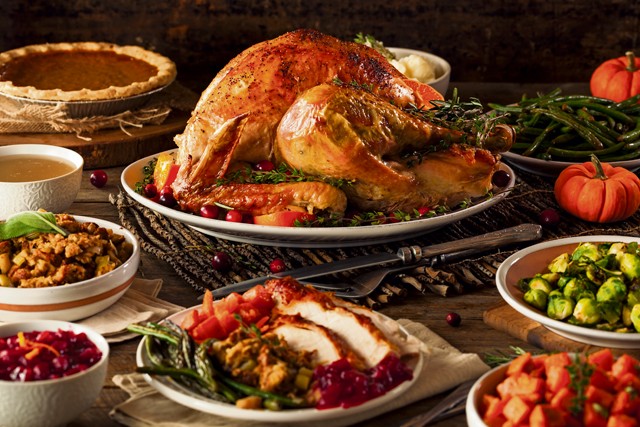As the holiday season quickly approaches, many of us are looking to spend some quality time with family and friends. Nothing draws us closer together than enjoying a delicious home-cooked meal with the ones we love, but things can take a turn for the worse if food safety is not kept in mind. The U.S. Centers for Disease Control and Prevention estimates that approximately 48 million people get sick from foodborne illness each year. Of those that contract a foodborne illness, 128,000 are hospitalized and 3,000 die. The following are a few food safety tips to keep you, your family and your friends healthy during the holidays.
Foods most commonly associated with foodborne illnesses are raw foods of animal origin; that is raw meat and poultry, raw eggs, unpasteurized milk and raw shellfish. Adequate cooking will kill most bacteria and their toxins. Fruits and vegetables consumed raw are also a particular concern. Washing can decrease but not eliminate contamination, so cooking to proper time and temperature is vital. Also, unpasteurized fruit juices can be contaminated if there are pathogens in or on the fruit that is used to make it. The best bet is to only drink pasteurized juices.
One of the biggest pitfalls many make when cooking for the holidays is they do not plan ahead. Make a list of all the foods that you will need to prepare your meals and know which foods need to be refrigerated or kept warm. Keep in mind which foods have short shelf lives to ensure you are using them before spoilage occurs. Know how long each food takes to thaw, prepare and cook to avoid time or temperature abuse.
Do not combine shopping for your foods with holiday gift shopping. If you must combine meal shopping with holiday shopping, bring along a cooler and ice to keep foods cold as you check off items on your gift lists.
Sanitize food contact surfaces — Wash counters, cutting boards, utensils and any other surface that will come in contact with food. Ensure you are using warm soapy water. After washing, wipe or spray with a bleach solution and allow to air dry. To get the proper concentration of bleach, add 1/2 tablespoon bleach to one gallon of water. Always allow food contact surfaces to air dry instead of wiping dry. Immediately clean up spilled foods. When serving foods, always use a clean plate and separate serving utensils for each food item.
Practice good personal hygiene — Wash your hands with soap and water before handling food. Wash hands with soap and water when switching foods during preparation. Wash your hands after smoking, eating, touching any part of the body, taking out the trash, playing with pets or taking breaks. Wash your hands after every chance of contamination. It is especially important to wash your hands after using the bathroom, assisting children in the bathroom or changing diapers. Use water as hot as you can comfortably tolerate and sing the Happy Birthday song to yourself in your head while washing. This will ensure you are washing long enough – 20 seconds. It is best to use disposable paper towels to dry your hands and throw them away after each use. Sneeze/cough into the crook of your arm and always away from food or other people. Bandage any cuts on your hands. Do your best to keep hair out of foods by wearing hats or tying up long hair. Keep fingernails neatly trimmed and clean.
Cook — Cook foods to the proper internal temperature. Always use a calibrated metal stem thermometer to check temperatures and measure at the thickest part of the food. Ground meat should look brownish when cooked to 160 F. Poultry can appear light or dark and should be cooked to an internal temperature of 165 F. Fish should look milky and flake easily with a fork when cooked to an internal temperature of 145 F. Cook turkey, stuffing, casseroles and leftovers to 165 F; beef, veal and lamb roasts to 145 F; “fully cooked” ham to 140 F and fresh ham, pork and egg dishes to 160 F. Keep hot foods hot. Cook plant foods to 135 F. Maintain a minimum internal food temperature of 135 F while serving to guests.
Cool — Cool all cooked foods down to 70 F within two hours and then down to 41 F within an additional four hours if not using immediately. This can be accomplished if you cool big pots of soup and stews by pouring them into smaller containers before placing into the refrigerator, using ice as an ingredient or by stirring the food in a container placed in an ice water bath. Keep cold foods cold. Maintain internal food temperatures below 41 F when serving to guests and storing. Do not thaw foods at room temperature and never rush the thawing process. Instead, thaw foods in a refrigerator that maintains an internal temperature of 41 F or below, or you can thaw foods as a part of the cooking process.
Cross-contamination — Separate food by product when purchasing, storing, preparing and serving. Separate stored raw foods from cooked foods and ready to eat foods. Use separate utensils, cutting boards, pots and pans for each food item you are preparing and serving. As hard as it might be, keep guests out of the kitchen to avoid the temptation of tasting foods as they are being prepared. Provide a serving utensil for all foods served to prevent germs on hands from spreading.
The holiday season is a very special time to spend with family and friends. There will be lots of preparation for big meals and shared bounty, so following these food safety precautions can assure wonderful gatherings and memories in your home.



